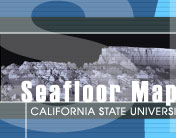



CAPABILITIES
|
The SFML Hyball ROV is used to acquire underwater video imagery for use in habitat identification, groundtruthing, and quantitative biological data collection. The Hyball has a 300 m depth capability and is fitted with four thrusters. Two main thrusters provide forward, reverse and rotational movement and two vertran thrusters provide vertical and lateral movement. The internally mounted video camera (JVC 470 line resolution, 0.95 lux color CCD with an F 0.8 Pentax lens) on the Hyball can tilt and view through 360 degrees. Panning of the camera is achieved by rotating the vehicle, which can turn on its own axis. Imagery is recorded on a JVC BR-DV600 mini-DV digital VCR. Two parallel 10mW lasers (10 cm separation) track with the camera, providing a scale reference in the recorded imagery. Telemetry and other information may be overlaid on the video image if desired. Tracking and positioning of the Hyball is provided by a Trackpoint II+ ultra-short baseline acoustic tracking system. The Trackpoint system has a 0.5 m slant range accuracy and a total horizontal position accuracy of < 0.5% RMS of slant range. Depth information is provided by a pressure sensor on the vehicle as well as by a 4337B Trackpoint multibeacon with depth telemetry. The Trackpoint system is interfaced to the topside vessel survey navigation system and provides realtime x,y,z positioning of the ROV in Coastal Oceanographic's Hypack Max software. The NMEA position data is also recorded directly on the DV tape using a Horita GPS-3 encoder. This device records the position data in an audio track on the video tape, where it can be easily accessed but does not obscure the video imagery. The R/V Macginitie is also equipped with redundant drop-camera systems for use in quickly obtaining seafloor substrate imagery in shallow (< 40 m) settings. One of these drop cameras is typically deployed with the petit ponar sediment grab when collecting samples for grainsize analysis and habitat groundtruthing. In
addition to the ROV and drop camera systems described above, underwater
video imagery is also collected using SCUBA divers equipped with
hand held underwater DV and Hi-8 cameras.
|
 Remotely
Operated Vehicle (ROV)
Remotely
Operated Vehicle (ROV)